|
BMW 1-Series (E81/87)
Debut: 2004
Maker: BMW
Predecessor: 3-Series Compact
|
|
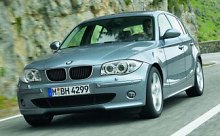 Since
the mid-90s, BMW realized it needs to expand its model line-up to lower
segment than the 3-series in order to steal sales from the likes of
Volkswagen
Golf. It therefore developed the Compact version of the 3-series. The
3-series
Compact was the only rear-drive family hatch in the world but it was
too
close to the 3-series (including price) such that there were not many
reasons
to buy it. After 2 generations of attempt, BMW is finally giving
up. Since
the mid-90s, BMW realized it needs to expand its model line-up to lower
segment than the 3-series in order to steal sales from the likes of
Volkswagen
Golf. It therefore developed the Compact version of the 3-series. The
3-series
Compact was the only rear-drive family hatch in the world but it was
too
close to the 3-series (including price) such that there were not many
reasons
to buy it. After 2 generations of attempt, BMW is finally giving
up.
Former
chairman
Dr. Joachim
Milberg understood that to broaden the range of BMW, a 1-series must be
added. It will also reduce the risk of over-reliance on the 3-series,
which
accounted for more than two-third of the company’s sales before the
launch
of Mini. 3 years ago, before his retirement, Dr. Milberg greenlighted
the
1-series project.
The
1-series
substitutes
the 3-series Compact as the world’s only rear-drive family hatch.
Rear-wheel
drive has its advantages and disadvantages. On the plus side, it
handles
better than front-wheel-drive cars, because the front wheels are
responsible
for steering only. This improves steering feel, reduce understeer and
eliminate
torque steer. Moreover, with the differential and drive shafts
relocated
to the rear, it is easier to achieve better chassis balance. In the
1-series,
BMW also shifts the battery to the rear, under the boot floor.
Furthermore,
it mounts the longitudinal engine far back in the long engine
compartment.
As a result, the 1-series really achieves 50:50 balance (at least for
4-cylinder
petrol engine versions), while most other family hatches have 2/3 of
their
masses over the front wheels.
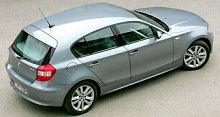 On
the road, the 1-series really handles fantastically. Its balance and
body
control is even better than the widely acclaimed Ford Focus, while
steering
is feelsome, precise, linear and well-weighted. We are glad that for
the
driver’s sake BMW did not switch to electrical (like Volkswagen) or
electro-hydraulic
steering (like Ford), because they never match the steering feel of a
pure
hydraulic system like the BMW’s. The good impression does not stop
there.
All controls on the baby BMW are superbly refined - the gearchange is
slick,
the brake pedal is linear and well weighted.... they deliver a quality
feel not found in this segment, Volkswagen Golf and Audi A3 included.
In
short, the 1-series replaces Ford Focus as the best handling, the most
fun to drive family hatch in the world. The only area it does not match
Focus is the ability to throttle steer, because its chassis was
designed
to handle more power than the current 4-cylinder engines can offer. On
the road, the 1-series really handles fantastically. Its balance and
body
control is even better than the widely acclaimed Ford Focus, while
steering
is feelsome, precise, linear and well-weighted. We are glad that for
the
driver’s sake BMW did not switch to electrical (like Volkswagen) or
electro-hydraulic
steering (like Ford), because they never match the steering feel of a
pure
hydraulic system like the BMW’s. The good impression does not stop
there.
All controls on the baby BMW are superbly refined - the gearchange is
slick,
the brake pedal is linear and well weighted.... they deliver a quality
feel not found in this segment, Volkswagen Golf and Audi A3 included.
In
short, the 1-series replaces Ford Focus as the best handling, the most
fun to drive family hatch in the world. The only area it does not match
Focus is the ability to throttle steer, because its chassis was
designed
to handle more power than the current 4-cylinder engines can offer.
Strictly
speaking, 1-series
has its own platform, but as much as 40% components are shared with the
next generation 3-series. This include the front MacPherson strut and
rear 5-link suspensions. To reduce the weight at nose, the front
suspensions
employ aluminum links and aluminum sub-frame on which they are mounted.
The rears are made in steel - in contrast to aluminum of 3-series - to
reduce cost. On the road, it rides with big car feel - smooth, quiet
and
refined. No surprise, because its suspensions are easily the most
sophisticated
(and expensive) in this segment.
 The
1-series is powered by some very good engines. At launch, only
4-cylinder
engines are available, but its long engine compartment was designed to
take on 6-cylinder engines also, no wonder a 180hp 2.2 inline-6 has
been
rumored. There are 2 petrol and 2 diesel engines. The cheaper petrol
engine
is a 1.6-litre 16V with 115hp and 111lbft. Another is a 2.0-litre
Valvetronic
16V with 150hp. Amazingly, this larger engine actually drinks less fuel
than the 1.6, thanks to the Valvetronic throttleless control. Moreover,
it runs smoothly and sweetly at all rev, thanks to twin-balance shaft.
The 2-litre engine work in companion with a slick-changing 6-speed
manual
transmission. It has tall gearing to enable relaxed cruising rather
than
outright acceleration, so the powertrain does not feel as sporty as,
say,
Alfa Romeo’s 2.0 JTS engine. However, as 120i weighs just 1260kg, it
can
still accelerate from rest to 60mph in 8.2 seconds and reach a terminal
velocity of 135mph. The
1-series is powered by some very good engines. At launch, only
4-cylinder
engines are available, but its long engine compartment was designed to
take on 6-cylinder engines also, no wonder a 180hp 2.2 inline-6 has
been
rumored. There are 2 petrol and 2 diesel engines. The cheaper petrol
engine
is a 1.6-litre 16V with 115hp and 111lbft. Another is a 2.0-litre
Valvetronic
16V with 150hp. Amazingly, this larger engine actually drinks less fuel
than the 1.6, thanks to the Valvetronic throttleless control. Moreover,
it runs smoothly and sweetly at all rev, thanks to twin-balance shaft.
The 2-litre engine work in companion with a slick-changing 6-speed
manual
transmission. It has tall gearing to enable relaxed cruising rather
than
outright acceleration, so the powertrain does not feel as sporty as,
say,
Alfa Romeo’s 2.0 JTS engine. However, as 120i weighs just 1260kg, it
can
still accelerate from rest to 60mph in 8.2 seconds and reach a terminal
velocity of 135mph.
In the diesel
side, the 1-series
offers a couple of 2.0-litre common-rail turbo engines. The so-called
116d
employs an ordinary turbocharger and produces 122hp and 206lbft. 120d
uses
variable-geometry turbocharger to produce 163hp and 251lbft. This make
it even faster than the petrol 120i, capable of topping 137mph and
reaching
60mph in 7.5 seconds. The tall gearing of 6-speed gearbox suits this
torquey
diesel very much. Using second-generation common-rail injection means
the
BMW diesels are quieter and more refined than Volkswagen group’s
pump-injection
diesel which you can find under the bonnet of Golf and Audi A3.
So, is it a
winner?
Not exactly.
For
the best
handling, 1-series pays the price in its cabin space. Rear-wheel-drive
not only introduces a thick transmission tunnel to the rear passenger
compartment,
limiting the car to 4-seater, but it also requires longitudinal
engines,
which occupy a lot more space than transverse engines that its FWD
rivals
employ. To achieve 50:50 balance, BMW pushes the engine even far back,
reducing the cabin length further. As a result, 1-series has to
sacrifice
rear passenger space to please the driver. Rear legroom is by far the
tightest
in the C-segment. Shame that BMW’s press release claimed it "offers
ample
shoulder and legroom for rear passengers". In fact, it is suitable to
children
or short adults only. The boot is also the smallest in its class.
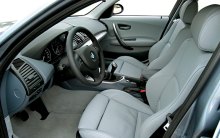  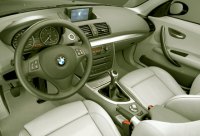
Perhaps this
explain why
since Alfasud and Golf brought FWD to the family hatch segment in the
70s
all other players in the field followed suit immediately. Cars this
small
cannot afford the penalty brought by RWD, unless they have a strong
favour
in driver appeal like the BMW. Admittedly, RWD is the only layout the
1-series
can afford. As Dr. Milberg said, without sharing extensive components
with
3-series it would be impossible to make money from the 1-series.
The interior
of
3-series
gives us a mixed impression. While the materials and build quality is
fine,
the dashboard and console looks too simple, Z4-like, without the
attractiveness
of Alfa Romeo 147 or the attention to details of Audi A3.
However,
the most
disappointing
is the odd-ball styling, again by Chris Bangle’s team. The basic
profile is
actually
conventional
- not unlike Alfa Romeo 147, but Chris Bangle ruined it with odd-ball
headlamps and
complex curvature
called "flame surfaces". The result is the ugliest BMW beside
X3. The only
success
is to achieve
a low drag coefficient of 0.29.
This question
again: is it
a class winner?
No.
To a family
hatch, I
guess a decent cabin space for 4 adults is a must, no matter how good
it
drives. Maybe it will make more sense in coupe form (rumours to be
called
2-series), but then again it will need a prettier styling to attract
the
niches. |
| The
above report was last updated on 16 Jul
2004. All Rights Reserved. |
130i
|
 The previous
generation 325ti Compact had a 192 hp 2.5-litre straight-6. That was
already a fast and fun small car. Now put a 265 hp 3.0-litre straight-6
into the smaller 1-Series body, what will it be? A flagship 1-Series? A
mini rocket? An Alfa 147GTA and Golf R32-beater? Or simply a thinly
disguised M-car? The previous
generation 325ti Compact had a 192 hp 2.5-litre straight-6. That was
already a fast and fun small car. Now put a 265 hp 3.0-litre straight-6
into the smaller 1-Series body, what will it be? A flagship 1-Series? A
mini rocket? An Alfa 147GTA and Golf R32-beater? Or simply a thinly
disguised M-car?
To call it the M-version of 1-Series is probably too exaggerate –
though some magazines prefer exaggerate headlines. The 130i has a mass
production engine like all mainstream BMWs, so it won't be qualified as
an M-car. Moreover, it lapped Nurburgring in 8 min 35 sec, some 21
seconds trailing the E46 M3, which sounds not very Motorsport indeed.
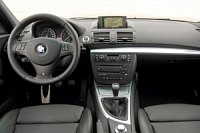 However, by hot hatch standard it can
easily shine. The 130i is powered by the company's masterpiece – the
lightweight magnesium block 3-litre inline-6 with Bi-Vanos, 3-stage
variable
intake and Valvetronic to achieve class-leading power and low fuel
consumption simultaneously. Unusually to BMW, this engine gets
additional tweaks such as enhance breathing and cooling to raise its
power (265 hp) and torque (232 lbft) above the standard engine (258 hp
and 221 lbft). That is the most powerful 3-litre engine since the
original 270 hp Honda NSX. Even compare with 147GTA and Golf R32's
larger 3.2-litre V6, the BMW engine delivers 15 more horsepower. No
wonder it claims 0-60 mph taking only 5.8 seconds, beating its rivals
by 0.1-0.2 seconds, and then reaching a true regulated top speed of 155
mph. Officially, the 130i carries 75 less kilograms than its big
brother 330i, which recorded 0-60 mph in sub-6 seconds by some
magazines, so the aforementioned performance is every bit
believable. However, by hot hatch standard it can
easily shine. The 130i is powered by the company's masterpiece – the
lightweight magnesium block 3-litre inline-6 with Bi-Vanos, 3-stage
variable
intake and Valvetronic to achieve class-leading power and low fuel
consumption simultaneously. Unusually to BMW, this engine gets
additional tweaks such as enhance breathing and cooling to raise its
power (265 hp) and torque (232 lbft) above the standard engine (258 hp
and 221 lbft). That is the most powerful 3-litre engine since the
original 270 hp Honda NSX. Even compare with 147GTA and Golf R32's
larger 3.2-litre V6, the BMW engine delivers 15 more horsepower. No
wonder it claims 0-60 mph taking only 5.8 seconds, beating its rivals
by 0.1-0.2 seconds, and then reaching a true regulated top speed of 155
mph. Officially, the 130i carries 75 less kilograms than its big
brother 330i, which recorded 0-60 mph in sub-6 seconds by some
magazines, so the aforementioned performance is every bit
believable.
On
the
road, the 130i's power delivery is smooth and linear. Working
with the sweet 6-speed gearbox, you can easily squeeze 7,000 creamy rpm
from the engine. Perhaps too smooth, you are confused whether it is a
flagship premium car or a super hot hatch. A little bit temper, a
little more sudden power boost could be more interesting.
 The same goes for handling and
ride. The standard 130i receives no suspension upgrade, riding on the
same ride height and 205/50 R17 tires as lesser models. Apart from the
increased performance, it feels little difference from 120i.
Admittedly, we said the 120i chassis could handle more power, so here
is what we asked for. 130i benefited from the inherent advantage of the
rear-wheel-drive, 50:50 balance and low polar moment of inertia,
therefore it handles agilely and accurately without resorting to stiff
suspensions. The result is much better ride comfort than 147GTA and
Golf R32. The same goes for handling and
ride. The standard 130i receives no suspension upgrade, riding on the
same ride height and 205/50 R17 tires as lesser models. Apart from the
increased performance, it feels little difference from 120i.
Admittedly, we said the 120i chassis could handle more power, so here
is what we asked for. 130i benefited from the inherent advantage of the
rear-wheel-drive, 50:50 balance and low polar moment of inertia,
therefore it handles agilely and accurately without resorting to stiff
suspensions. The result is much better ride comfort than 147GTA and
Golf R32.
Of
course, you can pay extra money to get harder suspensions, bigger
18-inch wheels, sports seats and extra body kits in the “M Sport”
package. But it has serious trade-off in ride quality, thus it is
better to save the extra money and choose the standard 130i.
Money is working against the 130i. In Europe, Alfa 147GTA and VW Golf
R32 are sold at E32,000, while 130i asks for E38,000, and that does not
include sport seats. In fact, for the same money you can
buy a Mitsubishi Lancer Evo IX or a Subaru Impreza STi, both capable to
do 0-60 mph in 4.6 seconds. In terms of speed, they are simply in
another class. In terms of driving fun, the BMW hot hatch cannot match
them either because it is too civilized, lack of 4-wheel traction and
limited slip differential. This means it can never catch the Japanese
rally cars in the twisties.
And don't forget it is
very ugly. This is absolutely a factor everybody should consider.
|
| The
above report was last updated on 10 Sep
2005. All Rights Reserved. |
Facelift 2007 and 3-door
|
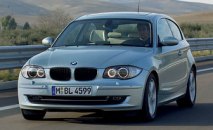 The
1-Series has received a facelift and an additional 3-door version
recently. For the facelift, you will be difficult to spot the
differences. The answer is a slightly larger double-kidney grille and
larger air intake at the front bumper. As a tradition of BMW, they
prefer mild styling changes. The
1-Series has received a facelift and an additional 3-door version
recently. For the facelift, you will be difficult to spot the
differences. The answer is a slightly larger double-kidney grille and
larger air intake at the front bumper. As a tradition of BMW, they
prefer mild styling changes.
Regarding the 3-door version, naturally, it looks cleaner and lighter
than the 5-door, but it is by no means as different as, say, from Opel
Astra 5-door to Astra GTC. It does not possess the beauty to justify
the scarification in accessibility to the already cramped rear cabin.
So who will want this car ? the answer is: if you don't like to take
your mother-in-law to picnic in weekends, you might just want this car.
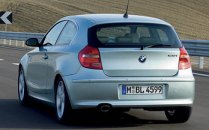 Obviously, the main purpose of
this facelift is neither the facelift itself nor the addition of
3-door, but to make the 1-Series greener. Like all major European car
makers, BMW promised EU legislators to meet the average car CO2
emission target at 140g /km by 2008. To achieve this, the 1-Series will
be very important. BMW introduces various fuel-saving technology to the
facelifted 1-Series: 1) all petrol engines bar 130i now employs direct
injection, making the less efficient Valvetronic no longer neccessary;
2) all diesel engines now employs
higher pressure second or third-generation common-rail injection; 3)
all manual
cars bar 130i gets automatic start-stop system to save fuel in urban
driving; 4) Brake Energy Regeneration* system uses the braking energy
to charge up battery for electrical systems to use; 5) Air-conditioning
is now electric-powered, thus no longer consumes engine power all the
time. 6) Fuel-saving electric power steering replaces the outgoing
hydraulic-assisted rack. Obviously, the main purpose of
this facelift is neither the facelift itself nor the addition of
3-door, but to make the 1-Series greener. Like all major European car
makers, BMW promised EU legislators to meet the average car CO2
emission target at 140g /km by 2008. To achieve this, the 1-Series will
be very important. BMW introduces various fuel-saving technology to the
facelifted 1-Series: 1) all petrol engines bar 130i now employs direct
injection, making the less efficient Valvetronic no longer neccessary;
2) all diesel engines now employs
higher pressure second or third-generation common-rail injection; 3)
all manual
cars bar 130i gets automatic start-stop system to save fuel in urban
driving; 4) Brake Energy Regeneration* system uses the braking energy
to charge up battery for electrical systems to use; 5) Air-conditioning
is now electric-powered, thus no longer consumes engine power all the
time. 6) Fuel-saving electric power steering replaces the outgoing
hydraulic-assisted rack.
Summing all up, the new 1-Series has its fuel consumption improved
significantly. For example, the 120i returns 44.1 mpg instead of the
previous 37.7 mpg. Carbon dioxide emission is reduced from 181g/km to
152g/km. At the same time, direct injection added 20 horsepower to the
engine (now 170hp) thus performance is improved too. Diesel engines
have similar improvement. For example, 120d now produces 177hp (from
163hp), returns 57.6mpg (from 49.5mpg) and emits 129g/km (from
152g/km).
 Unfortunately, the superb
dynamics of the 1-Series is compromised by the new steering. Electrical
assistance robs it of feel. Given the experience of Z4, BMW should have
predicted this long ago. Disappointingly, this time it puts emission
& fuel consumption on higher priority than driving pleasure. What
message does Munich want to send ? I am a little confused… Unfortunately, the superb
dynamics of the 1-Series is compromised by the new steering. Electrical
assistance robs it of feel. Given the experience of Z4, BMW should have
predicted this long ago. Disappointingly, this time it puts emission
& fuel consumption on higher priority than driving pleasure. What
message does Munich want to send ? I am a little confused…
* Brake Energy
Regeneration: its concept
is not unlike hybrid cars - instead of losing energy in engine braking,
the system uses the alternator to convert the kinetic energy from the
drivetrain into electricity, charing up an "Absorbent Glass Mat
battery". But unlike hybrid cars, the resultant electricity will not be
used to pull the car, but to supply the electrical systems and air
conditioning. Besides, the intelligent alternator is normally
disconnected from the drivetrain and only engage under braking, so it
won't consume horsepower like conventional alternator. BMW claims the
brake energy regeneration system contributes to a fuel saving of 3
percent. |
| The
above report was last updated on 6 Mar 2007. All
Rights Reserved. |
1-Series Coupe
|
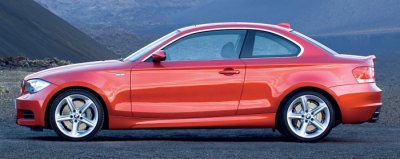
|
1-Series Coupe has a long bonnet and
short trunk, a proportion so wrong...
|
The relationship between
1-Series and 3-Series is always questionable. They are too close in
size, price and even performance because they share basically the same
mechanicals. As a result, most customers still prefer the larger car.
Last year, BMW sold some 500,000 units of 3-Series, versus 150,000
units of the 1-Series. That is not to say the baby BMW were a failure.
It just hasn't realized its potential. To broaden its appeal, since
earlier this year BMW is introducing more derivatives of the car – the
first was a 3-door hatchback, the second is a 2-door coupe, and then
there will be a 2-door convertible. The latter two are especially
important, as they will bring the 1-Series to the United States market
for the first time, even though 3 and a half years have already passed
since the birth of the 1-Series !
How to market the 1-Series Coupe is a headache. Considering the car
costs just 5,000 Euro less than the equivalent 3-Series Coupe – for
example, 135i Coupe costs 44,000 Euro while 335i Coupe costs 49,000
Euro – the baby Coupe doesn't have much marketing advantage. BMW
America calls it a "modern-day 2002", because the compact performance
car image of the 2002 is still strong in the mind of American buyers.
European magazines prefer to call the 135i as "junior M3", as they miss
the smaller and more agile 6-clinder M3s. Some may also link it with
the original E21 3-Series, as both are 2-doors and similarly sized. In
theory, the 1-Series Coupe should fill the vacancy left by the larger
and larger 3-Series Coupe.
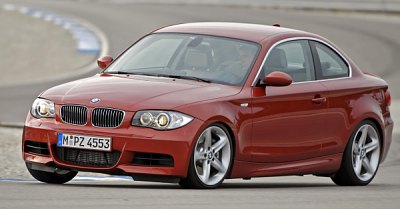
|
The famous, or notorious,
flame-surface design is carried over to the Coupe.
|
A glance at the specifications will
find the baby coupe some
22 cm shorter than the 3-Series Coupe, 3 cm narrower and 10 cm shorter
at wheelbase. The shorter trunk reduces luggage space from 430 to 370
liters. Drop in the rear seats and you will find it is more suitable to
children than adults unless for very short journey, because legroom is
so poor. The room up front is fine, but you will notice the narrower
cockpit and cheaper plastic dashboard not as desirable as its bigger
brother.
All these sacrifices could be justified if the 1er Coupe were 150 kg
lighter than 3er Coupe. Unfortunately, it isn't. Modern cars have most
of their weight spent on safety design, insulation, equipment,
suspensions and powertrain instead of sheet metals. And these are the
areas BMW unwilling to sacrifice in the 1-Series. It has the same
powertrain and suspensions as the 3er; it has the same refinement and
luxury features; it has the same crash worthiness and active safety
equipment. Comparing the remarkably similar 135i Coupe and 335i Coupe
will find the former is only 40 kilograms lighter. Yes, 40 kg. As a
result, the smaller car is barely faster. 0-60 mph takes 5 seconds
dead. Top speed is once again regulated at 155 mph. You can still
describe such performance as a junior M3 – especially note that it is
now faster than the new Mitsubishi Lancer Evo X which cost the same
money to buy – but you can say the same to 335i Coupe. Like the rest of
the range, 135i Coupe just fails to realize its potential.
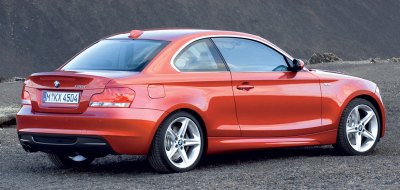
|
If you are looking for a Junior M3,
you will be disappointed. This small car is far more matured than you
might think.
|
The handling of 135i Coupe is also disappointing. Fitted with M-Sport
suspensions and wide, low-profile tires (215/40ZR18 front, 245/35ZR18
rear), in addition to the 50:50 weight distribution and a stiffer
2-door bodyshell, it should have delivered excellent handling.
Unfortunately, BMW tries too hard to please American customers by
setting its suspensions softer and building too much understeer into
the chassis (thanks to the narrower front tires and softer rear
anti-roll bar). As a result, it is an all-round high-speed cruiser
rather than an ultimate driving tool you would expect a "junior M3" to
be. The effortless performance from the super-torquey and lag-free
twin-turbo direct-injection 3-liter straight-6 adds to this feeling.
Yes, this motor is a gem, but a lightweight high-revving four-cylinder
motor like the original M3 would suit the 1-Series better and help
distinguishing it from 335i.
In fact, BMW does offer a terrific 4-cylinder engine to the 123d Coupe.
This is a 2.0-liter (don't fool by its name 123d) turbo diesel 16-valve
engine. It employs the latest high-pressure piezo common-rail injection
to boost power and economy. It also employs a two-stage
twin-turbocharging system like that of the 535d, which uses a small
turbo at low rev to quicken response and a large turbo intervenes
gradually from mid-rev to completely take over at high rev to boost
power. No wonder it produces as much as 204 horsepower and the same
torque as the 3.0 twin-turbo petrol. This is the first production
diesel engine producing over 100 horsepower per liter. This
four-cylinder diesel engine enables the 123d Coupe to do 0-60 mph in an
unbelievable 6.6 seconds and reach 148 mph on highway. What a pity the
123d is ruined by a numb steering feel, because it employs electrical
steering assistance in the name of energy saving. In contrast, 135i is
the only model in the 1-Series family to enjoy the natural feeling of
hydraulic power steering.
Apart from these two engines, BMW also
offers a 177hp 2.0
single-turbo diesel to 120d Coupe and a 230hp 3.0-liter naturally
aspirated six-cylinder petrol to the American-market 128i Coupe.
Apparently, there is room for a high-revving petrol four-cylinder to
join in the future. This has been implied by the 1-Series Tii concept
demonstrated in the Tokyo motor show. I hope BMW will build this car
(with hydraulic steering please !), otherwise I don't see there is any
good reasons to buy the 1-Series Coupe instead of the roomier,
better-built and more graceful-looking 3-Series Coupe.
|
| The
above report was last updated on 6 Nov 2007. All
Rights Reserved. |
1-Series Cabriolet
|
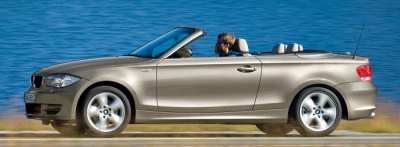
|
For the same price as Audi A3
Cabriolet, you get a rear-drive chassis, a 6-cylinder engine, a real
coupe shape and BMW quality, isn't it a bargain ?
|
Last time the 1-Series
Coupe
didn't impress us very much because it is neither as dynamically well
sorted as 3-Series Coupe nor as cheap as it ought to be. This time its
Cabriolet version is quite different. BMW sensibly chose a conventional
soft top for the little car instead of the folding metal roof employed
by 3-Series Cabriolet. As a result, the 1-Series Cabriolet can be
priced considerably lower than the equivalent 3-Series Cabriolet. For
example, 125i Cabriolet asks for "only" £26,200 in the UK market,
compare with £33,300 of 325i Cabriolet. For nearly the same price
of an Audi A3 Cabriolet 2.0 TFSI, you get a rear-drive chassis, a
desirable 6-cylinder engine, a real coupe shape and the BMW brand,
isn't it a bargain ?
Another advantage of the fabric roof is weight. It adds only 120 kg to
the coupe, so the weight difference from 3-Series is increased from 40
kg for the coupes to 145 kg for the cabriolets. Of course, less weight
translates to higher performance. Take 125i Cabriolet as example again,
it can sprint from rest to 60 mph in a brisk 6.5 seconds, compare with
7.2 seconds of 325i Cabriolet. Top speed is 148 mph. By the standard of
cabriolets this is very serious performance.
The smaller car does sacrifice something, such as a little bit rear
seat space. The legroom is reduced by 18 mm compare with the coupe,
while considerable shoulder room is eaten up by the chassis
reinforcement. That said, average-size adults are still acceptable at
the back. The boot, with 305 liters when the roof is up, can swallow a
pair of golf bags.
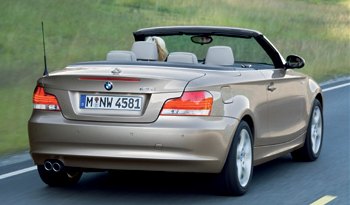
|
Fabric roof means 145 kg lighter than
the equivalent 3-Series, so performance is strong.
|
Don't be fooled by its name, the 125i
engine is actually a
2996 cc unit. Tuned for fuel efficiency, it produces 218 horsepower
instead of 265 / 272 hp and 199 lbft of torque instead of 232 lbft, but
it possesses the same rev eagerness, creamy smoothness and musical
engine note of traditional BMW straight-6. Other engines include 143 hp
2.0 four, 170 hp direct-injection 2.0 four, 177 hp 2.0 turbo diesel and
306 hp 3.0 twin-turbo six like 1-Series Coupe, but I suppose the 125i
engine is the best compromise between price, performance and
desirability. In the USA, its position is substituted by 128i whose
engine produces 230hp from the same capacity.
Inevitably, the 1-Series Cabriolet doesn't handle as good as its hard
top version due to the loss of chassis rigidity as well as the adoption
of a softer suspension setting. There is more understeer and less body
control in corners, but the ride is supple. However, thanks to 50:50
balance and rear-wheel drive, it is still more neutral and agile than
its front-drive rivals like Audi A3 Cabriolet, Volkswagen Eos and Volvo
C70. If there were a C-segment cabriolet more entertaining to drive, we
haven't discovered yet. |
| The
above report was last updated on 18 Feb
2008. All Rights Reserved. |
1-Series M
|
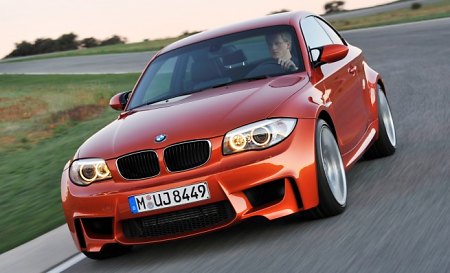
|
A question of name: isn't it more
appropriate to call it
M135i ?
|
BMW M3 has long been the
definitive affordable performance coupe. When the current generation M3
switched to V8 power and pumped up its price to over £50,000, it
became out of the reach of the majority. A space is deliberated
underneath it and, naturally, filling the space is the M version of
1-Series. BMW refused to call it "M1" as it could have confused with
the legendary M1 supercar. Instead, it calls the new car "1-Series M".
Excuse me for expressing more dissatisfaction with the name. This is
the first time I heard a BMW model includes the word "Series" in its
official name. Theoretically, "Series" means a
family of models, so it should not appear on a specific model.
Moreover, "1-Series M" sounds neither cool nor romantic. I think a more
appropriate name could be M135i. It reflects the fact that the car
shares a production engine with 135i, just like the M535i built in 1979-87. However, that is
exactly what BMW wants to avoid !
Munich tells us the 1-Series M is a modern-day original (E30) M3. Frankly, apart from their
similar lengths (the new car is just 20 mm longer), I found few things
common between them. The original M3 was built for motorsport purpose
and powered by a 2.3-liter DOHC 16-valve four-cylinder engine designed
and built specially by the motorsport department. The 1-Series M is
more like a beefed-up 135i Coupe. Although it does have a lot of aero
and chassis modifications (we will explore later), its heart is the
production N54 3.0-liter biturbo straight six, built on the standard
production line without using any special pistons, con-rods or valves.
It does produce higher output than that on the regular 135i, but not by
much – just 34 horsepower and 37 pound-foot of torque – and the same
tuning is already available on a non-M car, Z4 sDrive35iS.
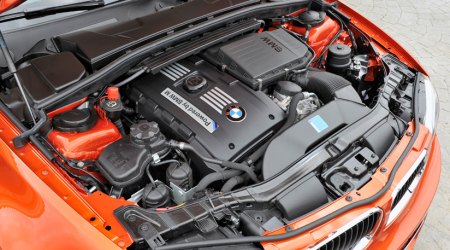 |
N54 biturbo straight six is built on
the standard production line, no wonder it lacks a proper M character.
|
Most disappointing, the turbocharged straight-six lacks the
high-revving character of traditional M-power engines. It produces
maximum power at just 5900 rpm, and its torque curve peaks from 1500 to
4500 rpm. The engine can spin to no more than 7000 rpm, a far cry from
the M3's 8400 rpm.
In terms of performance specifications, the 1-Series M is remarkably
close to the last generation (E46) M3.
Both run a straight-six engine with around 340 hp. Both tip the scale
at 1495 kilograms. As a result, their performance are closely matched.
The E46 accelerated from rest to 60 and 100 mph in 4.8 and 11.5 seconds
respectively. The 1-Series M may be a tenth or two quicker to sixty and
half a second quicker to the ton. Nevertheless, the way the driver feel
could not be any more different. On the old M3, you have to work hard
on every gearchange to keep the engine boiling at 7900 or 8000 rpm,
which is a joy to keen drivers or tiresome if you are not in mood. On
the 1-Series M, thick torque is always available for your disposal, no
matter at any rev. Performance is so easy to exploit that the driver
finds little merit, hence motivation, to work harder. BMW tuned this
version of N54 very well, with a brawnier exhaust note than the regular
version. Turbo lag is also minimum, as you can expect on the best
modern turbocharged engines. However, the thrill of accessing the
engine is somehow lost. Throttle response is no way as sharp as the
low-inertia naturally aspirated straight-six on the old M3. The
induction noise of the old engine revving at sky-high rpm is also not
what the turbocharged motor can replicate. In short, the new motor
trades emotion and thrills with better real-world performance and fuel
economy.
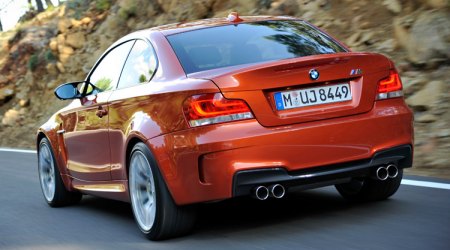
|
On back roads, the smallest M-car
could be faster than the V8 M3...
|
Fortunately, the chassis is properly
developed. The 1-Series M runs massively wider tracks – 71 mm up front
and 46 mm at the rear – than the 135i Coupe. Its suspensions owe a lot
to the current M3. The rear suspensions' control arms, dampers,
knuckles and subframe are made of aluminum instead of steel on the
regular 1-Series. Unsprung weight is further reduced by using hollow
anti-roll bars. Ride height has been lowered by 20 mm along with
stiffer springs and dampers. The steering, still hydraulic assisted,
has been quickened by 22 percent. The 19-inch lightweight alloy wheels
come straight from M3 GTS. The brakes are M3-specced: all-round
cross-drilled compound discs, 360 mm and 350 mm diameter front and rear
respectively. The Michelin PS2 rubbers are also M3-specced. Considering
this car is 85 kg lighter than its bigger brother, its handling prowess
is not to be doubted.
Most important, the 1-Series M gets Variable M differential lock,
something reserved for the M-cars until now. This should keep its
handling tidier than any other 1-Series models under hard driving.
Outside, the 1-Series M looks adequately sporty, thanks to its
aggressive air dams, large intakes, quad-tailpipes and especially
flared wheel arches. It gets more advanced aerodynamics, too. It has
the company's first road application of "air curtains" technology,
which uses ducts to draw air from the lower front intakes and releases
just before the front wheels, generating a curtain-like air stream to
cover the spinning wheels, thereby reducing turbulence and drag.
On the Road
On the road, these modifications translate to fabulous handling. The
baby M-car is really quick and agile in the twisty. Its weighty
steering is responsive and communicative, actually feeling more
faithful than that on the current M3. Its nose turns into bends far
more eagerly than 135i Coupe, thanks to that quick steering rack as
well as massive front end grip. In fact, the grip generated by those
Michelin rubbers is stunning for a coupe so compact. It allows the car
to carry big speed into corners. The suspension setting hits a balance
between tight body control and decent ride comfort. What about the
brakes ? simply invincible. They offer huge stopping power and superb
pedal feel simultaneously.
On back roads, the smallest M-car could be faster than the V8 M3,
believe or not. This is because its engine is so much more flexible,
offering significantly more juice at the low end of spectrum. In this
way, you can get back into power band more quickly after each bend. On
race track, of course, it won't be as quick as the M3.
But the superior low-end torque is not always welcomed. Its combination
with a short wheelbase and low weight could sometimes result in a
tricky behaviour at the limit. If you apply too much throttle at a
low-speed corner, you will find not even the M differential can contain
its wheel spin and tame its sideway. In comparison, the linear delivery
of traditional M-power is easier to exploit.
However, the biggest downside of the 1-Series M is still its
characterless engine. Is it wise to switch to turbocharging ? To the
ultimate driving enthusiasts, the answer is negative. Maybe one day
somebody would develop a turbocharged engine with 8000-plus rpm redline
and instantaneous throttle response using electrically assisted
turbine. Before that happen, it is hard to imagine a turbocharged motor
could better the previous straight-six, V8 and V10 built by the M
division. As a result, the new generation M cars will be very difficult
to match
their ancestors.
That said, if you can get over the glorious history of M cars, you may
still find the 1-Series M a wonderful driving machine. Yes, its
packaging might be outdated and its interior is almost spartan compare
with Audi RS3 or TT-RS, but judging on driving fun alone, nothing in
this segment and at this price can compare to it.
|
| The
above report was last updated on 12 May
2011. All Rights Reserved. |
|
|